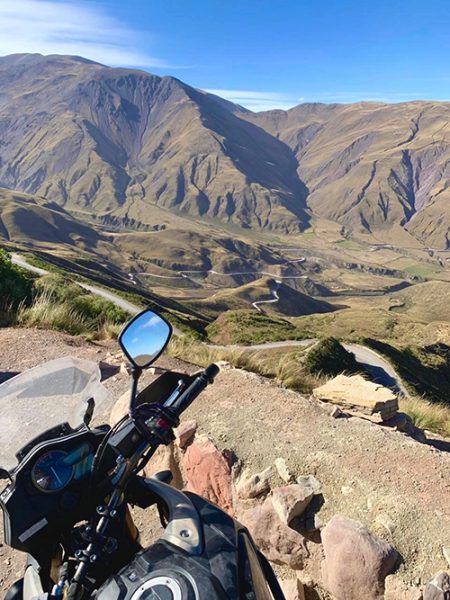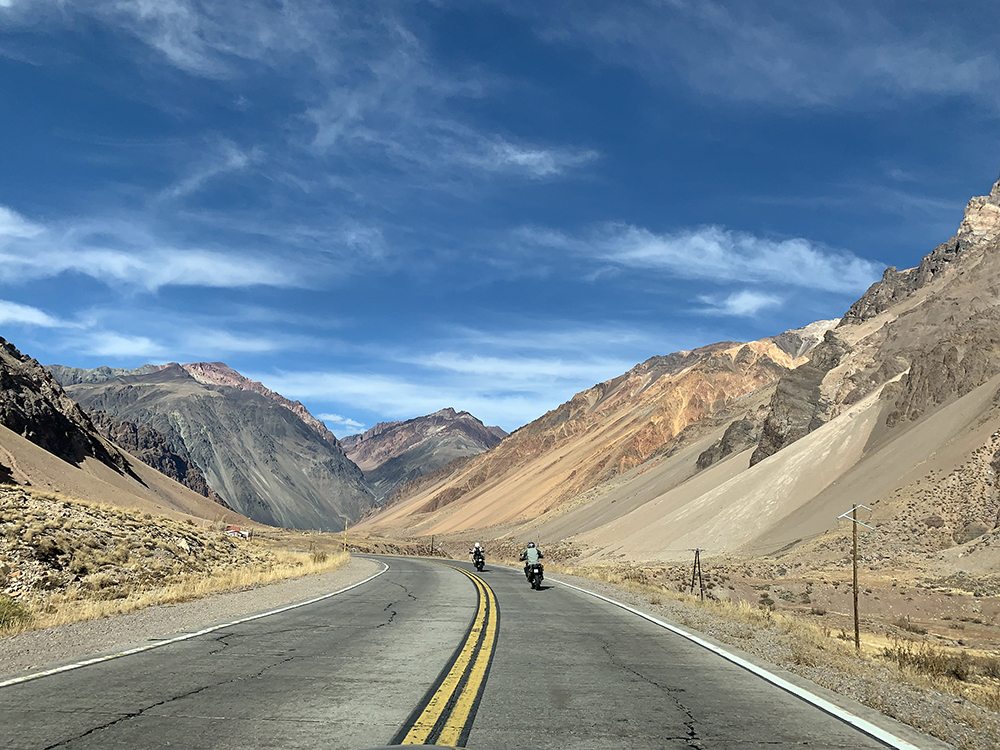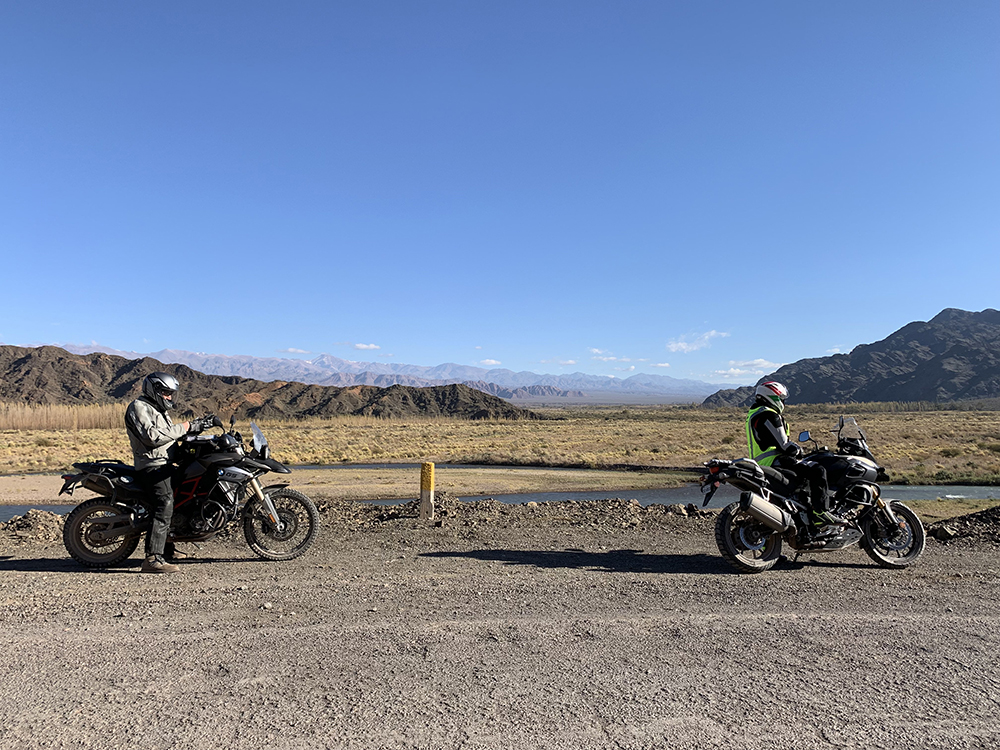Tracking Toby Price’s first Dakar victory through Argentina, Bolivia and Chile
The furrows carved across the landscape by the monstrous Kamaz trucks had been re-covered in sand, the Dakar bivouac sites had long returned to nature and the portaloos consigned to history. But for us there was always a comfortable bed and a cold beer nearby. And all bar 700km of our 10-day adventure was over paved roads, the worst exception being the loose rocks and sand of Bolivia. But this last section deposited us on to the Salar de Uyuni, said to be the largest salt lake on the planet.
Surveying the endless expanse of the Cordillera de San Buenaventure, it was easy to imagine the plight of Dakar competitors struggling across the sand, saltpans and spinifex in temperatures approaching 47°C. In those extreme conditions Toby Price was the only competitor to complete Stage 9 of the 2016 Dakar Rally, the stage cancelled due to the dangers of heat exhaustion. No such problems for us. The temperature never rose above 15°C.
However there we were. Imagining…
Ever since we’d ridden the length of the Atacama Desert to watch the Chilean Stages of the 2010 Dakar, we’d vowed to return to ride the Argentinean side of the Andes. And when old mate César Mora called to confirm the opportunity of a ride in May, it was only a matter of booking flights to Santiago.
César, the 2015 Chilean Superbike Champion, was carrying a back injury, but was more than fit enough to stay in front of a couple of less-talented gringo mates. Best of all, César’s son Cristian signed on as support and sweep; no need for panniers. You may well laugh, however taking on tight hairpin bends with a 17° gradient, on an unfamiliar bike on the ‘wrong’ side of the road, with convoys of semi-trailers in both directions, you need to stay as skinny as possible.

Within 24 hours of our arrival in Santiago – me from Oz and Dave from Cleveland, Ohio – we were riding through the Cristo Redentor Tunnel into Argentina. It was the last time we’d be at an elevation lower than the height of Mount Kosciuszko and the last time we’d suffer traffic for the next 10 days. At the end of that first day, after more than a little back and forth in the darkness, we found a posada and, more importantly, a taberna. I was reminded once more, how much tastier scoff becomes and how much happiness a simple beer can bring as an alternative to another hour or more in the saddle. The next morning we were in the moment, ready to ride.
Study any map of the western regions of South America and the boldest descriptor will read Cordillera de los Andes – the Andes Mountains. Simple enough, however the Andes incorporate over 100 distinct mountain ranges such as the Cordillera de Lipez or, should you prefer, the Cordillera de Claudio Gay. Then within these major cordilleras there are a thousand Sierras – local mountain ranges – the most significant being the Sierra de Aguas Calientes and the Sierra de Aguas Calalaste. Any flat bits left over are covered with cumbres (summits) and carros (hills), while the less lumpy bits are the pampas or punus – vast treeless plains. The really flat bits become salt lakes. And the annual snow melts carve impressive quebradas (gorges) across the landscape which, on occasion, become immense valleys such as the Valle de Lermas. And all these rocks on steroids on display within the vast, ill-defined expanse of the Atacama Desert, through which roads are few and traffic scarce.
National Route 40 winds the length of Argentina, over 5000 kilometres from Santa Catalina in the north to Zurdo in the south. Now mostly paved, it transcends Route 66 for its natural grandeur; none better seen than from the unpaved section between the picturesque town of Cafayate in the wine region, north along the Valle de Cachaquies, to Cachi. A 200km ride that has no equal for variety of scenery, coupled with the need to remain focussed through the tight, and occasionally sandy, twisties. And blind, single-lane switchbacks.


Tiny whitewashed Cachi is home to El Aujero – famous for its local cuisine such as charito and charquicillo – or, for me, a simple empanada or two. It was most pleasant in the sunny courtyard at 26°C despite the 2100-metre elevation. A very short ride across the northern fringe of the Parque Nacional de Cardones later we passed over the Cuesta de Obispo at 3800 metres – an average rise of 100 metres per kilometre. The descent was even steeper. If you fancy challenges, pencil Ruta 33 into your bucket list. And if you make it to Salta, head straight for the Hotel Salta on the main square to get a true taste of Argentinean lifestyle, before highrise and pre-fab concrete arrives.
And so, on we rode, higher and higher, yet on the sixth day of our ride, I was still a little apprehensive. The medium-to-well-done loin of llama eaten the previous evening had settled – assisted by the delightful local cabernet sauvignon. A far too early hit of nicotine didn’t settle my nerves, either. Thirty minutes and 20 kilometres later my fear of ever ascending hairpin bends had disappeared. Along with the oxygen. We were above 4900 metres, the temperature had dropped to -3.5°C. Wind chill exacerbated conditions and I was attempting to recall the symptoms of hypothermia as I braked slowly through a never-ending succession of hairpins to the vast salt flat – Laguna de Guayatayac – back to a mere 2300 metres of elevation.
The road across the Salinas Grandes was ruler straight and the ambient temperature had climbed to zero. Next came Susques at 3900 metres followed by Salar de Cauchari at 2200 metres, then back up to the Paso Jama at 4200 metres. And so on. And on.
We crossed the border from Argentina to Chile on the eastern fringes of the Atacama Desert. And into a brutal crosswind. By the time we entered San Pedro de Atacama (the home of the only brewery in Chile’s Atacama Desert – the driest on our planet. And the perfect place to enjoy a cold glass of Saint Peters Lager), this remote desert outpost was engulfed in a sandstorm, our contribution being a few laps of town on the way to locating our digs. After which we quickly repaired to the local cervezeria. Una, dos, tres, quatro cervezas later it was time to remove the boots, shower, find some music, study the wine list and talk shit for several hours. The following day we were headed to the Palacio de Sal in Bolivia on the fringe of Lake Uyuni, the largest salt lake in the world. Nothing above 3500 metres for the day. Easy.

Due to border formalities in the godforsaken outpost of Ollague – which closes for lunch, regular football games and quite possibly other reasons when the Bolivians are having a tiff about some event that happened back in 1564 – we spent almost four hours shuffling paper. An eight-hour ride became a 12-hour day. And it could have been longer had Dave been unable to prove his Yellow Fever inoculation. Bureaucracy is the same the world over.
Lake Uyuni is over 12,000 square kilometres and around 3500 metres elevation with 10 million tonnes of salt – less than that used in the construction of Palacio de Sal, the only hotel in the world made entirely from blocks of salt. Dakar watchers will recall Salar de Uyuni as the Stage that almost brought the entire 2015 event to a premature ending. But on our 120km return ride out to the Isla de Cactus, we experienced nothing but hard, smooth salt that disappeared over the horizon at all points of the compass.
Having suffered a rough ride on Ruta 701 north we tried Ruta 5 on the way south, following the still-in-use, narrow rail line through Rio Grande, Fulaca and San Juan – all suffering heart-stoppers in the sand around the Salar Chiguana, though we cleared the border back into Chile in less than two hours. And were back in San Pedro de Atacama for happy hour.
Who couldn’t be happy in a town where the only brewery was named after me?
Other than the flight back to Santiago and a final meal with our host César it was all over bar the laughter. Ten days, over 4000km and over 50,000 metres of elevation – with nothing to show for it bar a little liver damage. Perfecto!


Words & photography Peter Whitaker